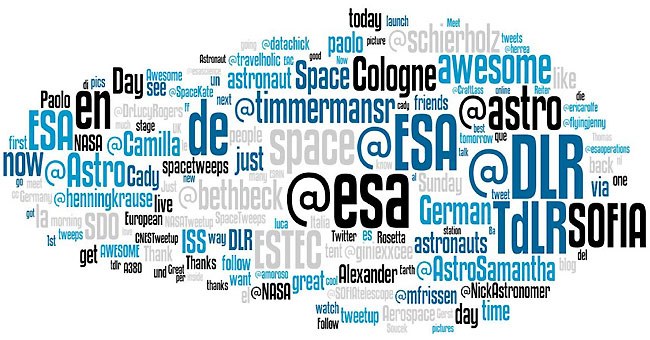Space Tweetup in numbers
For us as the Corporate Communications Department it is, of course, important to judge the success of particular measures (or lack thereof). In the case of the Space Tweetup, evaluation was carried out using social media monitoring tools. I will briefly summarise the most important results below.
Relevance
As part of the first European Space Tweetup, a total of 21,464 relevant social media contributions (that is, postings on Twitter, Facebook, Flickr, Youtube etc.) were identified and analysed quantitatively. To determine the perception of the event, a sample of 3589 postings on various social media channels was evaluated qualitatively.

Image: Quotes and Mentions of the first European SpaceTweetup. Credit: DLR, CC-BY 3.0.
Potential readers
The number of potential impressions generated by the Space Tweetup totaled about 19.3 million. 19.3 million potential impressions are an indicator of the relatively wide reach achieved via social networks with regard to the content and themes of German Aerospace Day and the associated Space Tweetup. By potential impressions, we mean the number of potential readers and their contact with the contents published in the various social networks, which included text, pictures, videos, links and blog articles on Twitter, Facebook, Youtube, Flickr, etc. Potential impressions were determined by the number of contributions; these were determined by social media monitoring software and multiplied by the number of followers of the respective channels. In the case of the Space Tweetup, and with regard to Twitter, the formula was:

(Number of tweets × number of followers of the 121 most active channels) + number of remaining tweets times 27 (the assumed average follower number according to hubspot.com)
Platforms
The basic idea of a tweetup is to generate a high level of buzz and, thus, widespread public attention through microblogging. For this reason, it is not surprising that the twitterers (also called 'tweeps') selected for this event generated the buzz largely via Twitter: 58.8 percent of all postings can be attributed to the microblogging service. In this respect, other social media channels were less important. Postings on photo or video channels such as Youtube or Flickr totalled 26.9 percent of traffic; 14.1 percent of the buzz (including 'Likes') took place on Facebook. Although blogs (0.2 percent) and forums (0.1 percent) played a minor role due to the mass of postings on the above mentioned platforms, they offered high quality content.
Image

The high percentage of postings with a favourable character (61.7 percent) shows the positive image of the event. Here, the fascination with and enthusiasm for aerospace, as well as the content offered by DLR and ESA, took centre stage. Particularly noteworthy in this respect was the '#awesome' tag that the tweeps attached to thousands of tweets, and which eventually became the unofficial motto of the event. 38.1 percent of the postings were neutral in tone; these were highly informative contributions that transmitted little emotion. Only an extremely small number of postings about the event could be considered critical (these, for example, expressed scepticism regarding access to the invited astronauts).
Viral public relations
If we look at the authors’ analysis of the Space Tweetup postings, we can see a concentration on specific channels considered particularly important by the users or tweeps. These included the Twitter accounts of the invited VIPs such as speakers and astronauts, but also those of the more noticeable tweetup participants, such as journalists or other 'influencers'. The channels of these VIPs and influencers were in turn frequently shared and multiplied, resulting in the - conceptually desired - effect of viral public relations. This was supported by the 'official' channels for the event, such as the @spacetweetup Twitter account run jointly by DLR and ESA. The Facebook groups set up by participants and other aerospace fans specifically for the first European Space Tweetup (some of them public) also intensified the viral effect.
A total of 121 members of the twitterati were identified who each produced at least 20 tweets during the observation period. In total, this group tweeted 9,257 times about the event. The number of followers of these most active channels alone totaled 242,386 potential readers (not adjusted for possible overlaps). The number of Twitter authors discovered during the evaluation period was 1349.

Image: Cloud of Influencers. Credit (DLR, CC-BY 3.0)
Conclusion
The total number of postings about the event shows that the Space Tweetup generated a lot of interest among the digital public - this is evident given the thousands of tweets produced on the day of the event. Because of the large number of different authors, DLR and ESA were made accessible to a very large potential readership in the course of German Aerospace Day with the help of the Space Tweetup.
At the time of writing, three more European Space Tweetups have already taken place (in chronological order):
- ESA-ESTEC SpaceTweetup on 9 October in Noordwijk, Netherlands
- Mars500Tweetup on 6 December 2011 in Rome, Italy
- ATVtweetup on 28/29 March 2012 in Toulouse, France
Further SpaceTweetups are already being planned. Please follow @DLR_en, @ESA or @SpaceTweetup on Twitter.
All images: DLR, CC-BY 3.0.
Tags:
